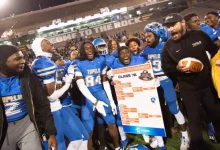Ryan Day pushes back on claims that NIL played a decisive role in Ohio State’s national championship aspirations, emphasizing team effort.

Ryan Day, the head coach of Ohio State University’s football team, has been at the center of many conversations about the intersection of college athletics and the new era of the Name, Image, and Likeness (NIL) rights. While NIL has revolutionized the landscape of college sports by allowing athletes to profit from their personal brands, it has also sparked intense debates about its impact on the competitive balance of college football. Some believe that NIL has allowed programs with the most financial resources to dominate, while others, like Day, argue that it is only one component of a broader picture. Recently, Day made headlines by pushing back against the claims that NIL played a decisive role in Ohio State’s national championship aspirations, choosing to emphasize the importance of team effort, culture, and coaching over financial incentives.
NIL: The New Era of College Athletics
The introduction of NIL rights in 2021 was a game-changer for college athletics. For years, college athletes had been prohibited from profiting off their name, image, or likeness, even as universities, coaches, and networks profited handsomely from the athletes’ performances. The NIL ruling overturned decades of NCAA policies, allowing athletes to sign endorsement deals, receive compensation for social media promotions, and even engage in business ventures.
While NIL was seen as a positive development by many, bringing fairness and equity to college athletics, it also introduced new challenges. Some critics argued that it could lead to an uneven playing field, where the wealthiest programs and boosters could offer lucrative deals to top-tier athletes, potentially undermining the competitive balance of college football. Programs like Alabama, Texas, and Ohio State—with their massive fan bases, deep-pocketed donors, and large media presences—were seen as being in a prime position to benefit from NIL, raising concerns about the future of parity in college football.
For programs like Ohio State, whose football team has long been a national powerhouse, NIL presented both opportunities and challenges. Ohio State, with its elite recruiting classes and tradition of success, was already a top destination for high school prospects. Now, with NIL, the Buckeyes had the chance to further sweeten the pot, potentially offering athletes even more incentives to play for them. But did this financial advantage make all the difference in their pursuit of a national championship?
Ryan Day’s Response to NIL-Driven Championship Claims
In recent interviews, Ryan Day has expressed his frustration with the growing narrative that NIL is the primary factor driving Ohio State’s pursuit of a national championship. Day has consistently pushed back against these claims, emphasizing that football is a team sport, and winning a national championship is about much more than just financial resources.
“Look, NIL has an impact, no doubt about it,” Day acknowledged in a press conference. “But to say it’s the driving force behind our championship aspirations would be a disservice to the players, coaches, and the culture we’ve built here at Ohio State.”
Day’s statement highlights a critical point in the debate surrounding NIL: while it plays a role in the recruiting process and athlete retention, it’s not the be-all and end-all for teams that aim to compete for national titles. In fact, Day’s Ohio State program, which has made multiple appearances in the College Football Playoff (CFP) under his leadership, is a prime example of a team that continues to prioritize other key factors, including coaching, player development, and team culture.
Team Effort and the Ohio State Culture
Ohio State has long been known for its tradition of excellence and its ability to develop elite football players. Under Ryan Day, the program has continued to thrive, consistently competing at the highest level. While NIL deals certainly play a role in attracting top talent, Day and the Ohio State staff have stressed that the foundation of the program is built on teamwork, discipline, and a culture of accountability.
The culture Day has instilled at Ohio State is one that emphasizes preparation, work ethic, and mental toughness. “We recruit people, not just players,” Day often says. The focus is on bringing in individuals who not only have the physical tools to succeed but who also have the right mindset to thrive in a high-pressure environment like Ohio State football. This approach has been central to the Buckeyes’ continued success, as Day has been able to recruit top-tier talent and develop it into championship-caliber players.
This emphasis on team culture is particularly important in the context of NIL. While NIL can attract players with lucrative opportunities, it doesn’t necessarily guarantee success on the field. The key to building a championship-caliber team is creating an environment where players are motivated to work together toward a common goal, not simply driven by individual financial incentives. Day has long maintained that success comes from players who are committed to the team first, rather than their personal brand or endorsement deals.
“I want players who care about winning, who care about each other, and who want to be a part of something bigger than themselves,” Day explained. “That’s what we’ve built here at Ohio State.”
The Role of Coaching in Building Championship Teams
Another critical factor in Day’s pushback against the notion that NIL drives championships is the importance of coaching. Day, who has an extensive background as an offensive coordinator and quarterbacks coach, knows better than most that talent alone is not enough to win at the highest level. Coaching is essential in developing players, executing game plans, and making critical adjustments throughout the course of a season.
Under Day’s leadership, Ohio State has had some of the best offenses in college football. His work with quarterbacks, including helping develop Justin Fields, who went on to become a first-round NFL draft pick, is well-documented. The success of Ohio State’s offense is not just a product of individual talent but also a result of Day’s ability to coach players to their full potential. Whether it’s developing quarterbacks, honing offensive line play, or scheming for opposing defenses, coaching is at the heart of the Buckeyes’ success.
Furthermore, Day’s coaching staff has consistently proven that they can develop players in all areas of the game. From offensive linemen to defensive backs, Ohio State has produced NFL-ready talent across all positions. This development is essential in building a championship contender. While NIL may help bring talented players to Ohio State, it’s the coaching staff’s ability to mold these players into cohesive, disciplined, and effective units that is ultimately the difference-maker.
The Balance Between NIL and Traditional Recruitment
While Day is quick to downplay the idea that NIL is the sole factor in Ohio State’s pursuit of a national championship, it’s important to acknowledge that NIL is a new reality in college football recruiting. The days of amateurism in college sports are over, and the ability to offer NIL deals is now part of the recruiting conversation. However, Day has stressed that NIL should be viewed as just one tool in the recruiting toolbox, not the driving force behind a program’s success.
“At Ohio State, we’ve always recruited top talent,” Day said. “But we’ve also recruited players who fit our culture and understand what it means to be a part of this program. NIL is part of the recruiting process now, but it’s just one factor among many. Our focus is on finding players who want to be a part of something special.”
This nuanced view is important in understanding the future of college football recruiting. NIL is undoubtedly a game-changer, but it is not a replacement for the traditional elements of recruiting—evaluating talent, fostering relationships, and building a program culture. For Day and Ohio State, the goal is to create a balance between embracing the opportunities of NIL and maintaining the traditions and values that have made the program successful for generations.
The Importance of Player Development
Another area where Day pushes back against the narrative that NIL plays a central role in championship aspirations is player development. NIL may help recruit top-tier talent, but it’s the development of that talent that determines whether a team can truly compete for a national title. At Ohio State, player development is a top priority. The coaching staff works tirelessly to develop players not only on the field but also off the field, focusing on their growth as individuals and leaders.
Day’s philosophy centers on the idea that championships are won through consistent effort, growth, and adaptability. While NIL might offer financial benefits to athletes, it does not replace the hard work, discipline, and resilience required to achieve success at the highest level. Whether it’s refining a player’s technical skills, improving mental toughness, or teaching leadership, Day believes that development is the key to sustaining success and ultimately achieving a national championship.
A Broader Perspective on College Football Success
Ryan Day’s pushback against the notion that NIL alone drives Ohio State’s national championship aspirations reflects a broader philosophy about what it takes to win at the highest level in college football. While NIL is undeniably a part of the current landscape of college athletics, it is far from the only factor in determining success. For Day and Ohio State, the focus remains on building a team culture, developing players, and emphasizing coaching as the foundation for sustained success.
As the landscape of college football continues to evolve with NIL, the true measure of a program’s success will still come down to the collective effort of the players, coaches, and staff. NIL may play a role in attracting talent, but it is not the deciding factor in winning championships. For Ryan Day and Ohio State, success will always be about more than just the financial incentives—it’s about creating a culture of excellence and teamwork that transcends individual gain.









